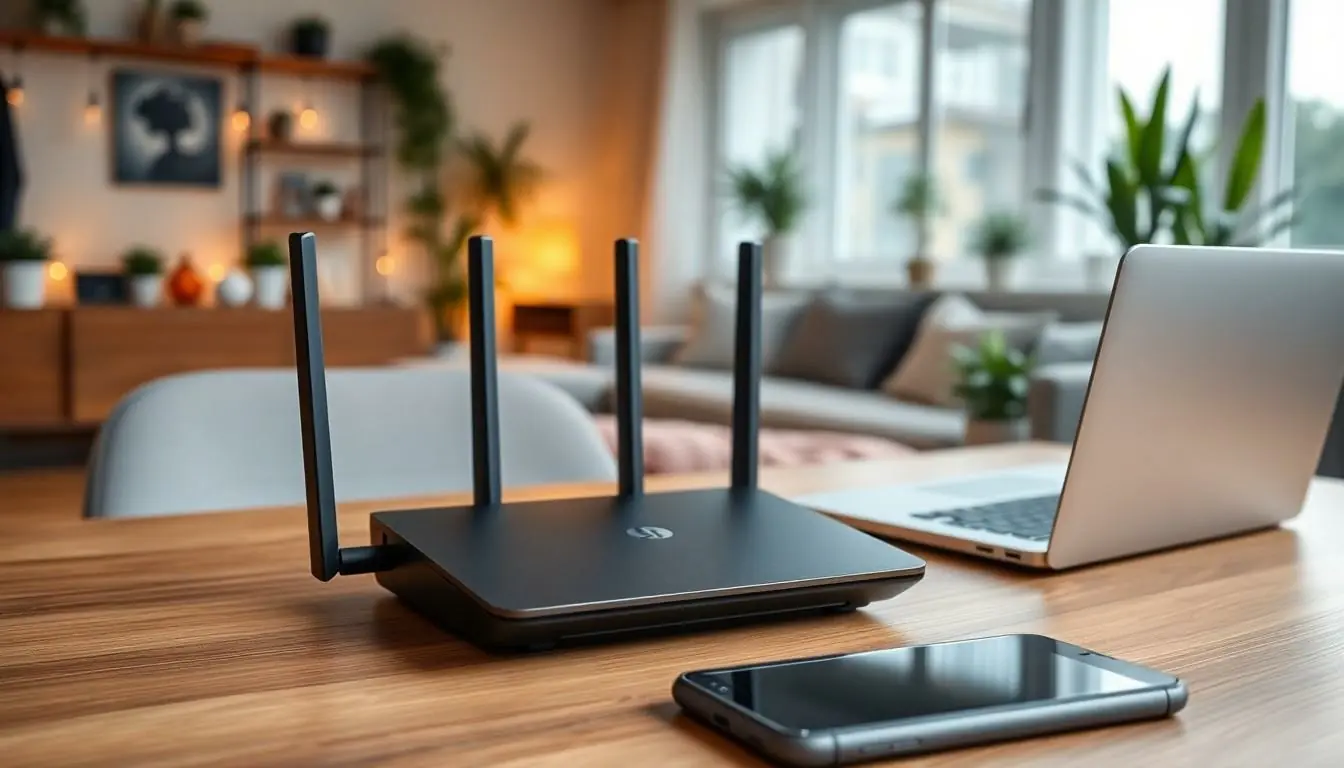Table of Contents
ToggleIn today’s tech-savvy world, home networking devices are the unsung heroes of modern living. They keep the Wi-Fi flowing, the video calls crisp, and the Netflix binge-watching uninterrupted. As more people work and play from home, the demand for reliable and speedy internet connections has skyrocketed. It’s not just about connecting to the internet anymore; it’s about creating a seamless digital experience that won’t leave anyone pulling their hair out.
Overview Of The Home Networking Device Market
The home networking device market has expanded significantly, driven by increasing digital needs. Reliable connectivity remains essential for work and entertainment activities.
Current Trends
User preferences favor high-speed and dependable devices such as routers and mesh systems. The shift to remote work and home entertainment demands solutions that prioritize seamless connectivity. Evolving technologies like Wi-Fi 6 and 5G significantly enhance performance. Increased adoption of IoT devices adds pressure to home networks, boosting demand for scalable solutions. Energy efficiency also gains attention, with consumers opting for devices that lower power consumption. Companies now emphasize multi-purpose devices, combining security features with performance enhancements.
Key Players
Major players dominate the home networking device market. Cisco is recognized for its enterprise-grade solutions. Netgear excels in creating user-friendly routers and extenders. TP-Link markets affordable yet capable devices, appealing to budget-conscious consumers. Asus is known for its innovation in gaming routers, targeting a specific consumer base. Linksys maintains a strong presence in the traditional home networking segment. These companies consistently develop cutting-edge technology to meet the evolving demands of users.
Types Of Home Networking Devices

Home networking devices facilitate seamless internet access and connectivity within residential environments. Key categories include routers, switches, and extenders, each serving distinct yet complementary roles.
Routers
Routers serve as the central hub for home internet connections. These devices direct data traffic between the internet and connected devices, ensuring efficient communication. Users favor models featuring the latest technologies like Wi-Fi 6, which provides faster speeds and improved security. Additionally, routers come with various configurations, including single-band and dual-band options, catering to different user needs. The convenience of built-in security features also enhances protection against cyber threats.
Switches
Switches expand the network by connecting multiple devices through wired connections. They function by directing data packets only to the devices that need them, improving overall efficiency. Various switches exist, such as unmanaged and managed models, providing flexibility for different configuration requirements. Managed switches offer advanced settings, allowing users to monitor network performance and optimize traffic. Businesses often rely on switches in conjunction with routers for robust network infrastructure.
Extenders
Extenders amplify existing Wi-Fi signals, improving coverage in larger homes. These devices effectively eliminate dead zones, ensuring a stable connection throughout the premises. Users typically set up extenders to enhance performance in areas where the router’s signal is weak. Some extenders feature dual-band capabilities, maximizing speed in homes with multiple devices. Placement remains crucial; extending the network coverage successfully depends on proper positioning between the router and the area needing improved connectivity.
Market Dynamics
The home networking device market demonstrates significant dynamics shaped by evolving user needs. Key factors drive its growth while others present challenges.
Drivers
Increasing digital needs motivate consumers to seek faster, more reliable internet connections. Remote work accelerates the demand for high-performance devices. Wi-Fi 6 enhances speeds, benefiting those requiring seamless video streaming. The rise of IoT devices prompts users to opt for scalable networking solutions. Enhanced connectivity supports smart homes, creating a more integrated digital experience. Energy-efficient devices capture consumer interest, reducing costs and environmental impact. Market players innovate continuously, ensuring products meet these growing requirements.
Challenges
Market growth encounters obstacles, including rapid technological advancements posing integration difficulties. Consumers express concerns about device compatibility as new technologies emerge. Security threats also command attention, pushing manufacturers to prioritize robust protection features. Price sensitivity affects purchasing decisions, particularly with budget-conscious consumers. Ongoing market competition leads to saturation, compelling companies to differentiate their offerings. Supply chain disruptions can limit availability, impacting consumer access to desired devices. These challenges require companies to stay agile and responsive to the ever-changing landscape.
Regional Analysis
The home networking device market exhibits significant regional variations, primarily influenced by technological adoption and consumer preferences.
North America
North America leads the market, fueled by advanced technology adoption and high internet penetration rates. The demand for high-speed routers and mesh networking systems dominates consumer preferences. Companies like Cisco and Netgear play key roles, continuously innovating to enhance user experiences. Increased remote work and decision-making by consumers strongly focus on reliable connectivity. Wi-Fi 6 adoption is substantial, improving the overall performance of home networks. In addition, consumers prioritize energy-efficient devices that contribute to sustainability efforts, increasing sales in this sector.
Europe
In Europe, the home networking device market grows rapidly due to increasing digital transformation initiatives. Customers emphasize the importance of robust security features in networking devices, reflecting rising concerns about data privacy. The popularity of IoT devices boosts this demand, with manufacturers responding by offering scalable solutions that support diverse applications. Prominent brands, including TP-Link and Asus, focus on creating high-performance products that align with regional energy efficiency standards. Additionally, increased interest in smart home integration motivates consumers to upgrade their existing home networks to accommodate more connected devices.
Asia-Pacific
Asia-Pacific’s market rapidly expands, driven by urbanization and rising disposable incomes. Here, the adoption of high-speed internet access accelerates growth, leading consumers to invest in advanced networking devices. The region’s young population avidly engages with technology, increasing the demand for seamless connectivity to support various online activities. Companies like Linksys adapt their marketing strategies to target tech-savvy consumers while addressing the unique challenges of diverse urban environments. Furthermore, the increasing number of smart homes in this region underscores the importance of reliable networking solutions for enhanced user experiences.
The home networking device market is evolving rapidly to meet the increasing demands of consumers seeking reliable and high-speed internet connectivity. As remote work and digital entertainment become integral parts of daily life, the need for efficient networking solutions continues to grow.
Innovations in technology such as Wi-Fi 6 and the expansion of IoT devices are shaping the future of this market. Companies must stay ahead of trends and address challenges like security and compatibility to thrive in this competitive landscape.
With a diverse range of products available, consumers can find tailored solutions to enhance their home connectivity, making informed choices essential for optimizing their digital experiences.





